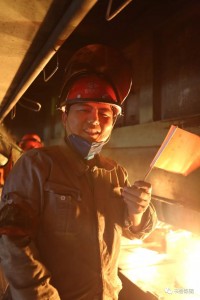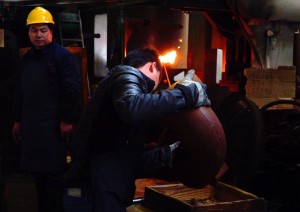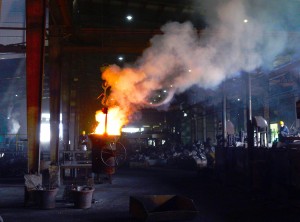With the development of science and technology and the vigorous development of foundry industry, different foundry methods have different mold preparation contents. Taking the most widely used sand mold casting as an example, mold preparation includes two major tasks: modeling material preparation, modeling and core making. In sand casting, all kinds of raw materials used for molding and core making, such as casting raw sand, molding sand binder and other auxiliary materials, as well as molding sand, core sand and coating prepared from them, are collectively referred to as molding materials. The task of preparing molding materials is to select appropriate raw sand, binder and auxiliary materials according to the requirements of castings and the properties of metals, and then mix them into tools according to a certain proportion Molding sand and core sand with certain properties. The commonly used sand mixing equipment includes wheel mixer, counter current mixer and continuous mixer. The latter is specially designed for mixing chemical self hardening sand, which is continuously mixed and has high mixing speed.


Molding and core making are carried out on the basis of determining the molding method and preparing the molding materials according to the casting process requirements. The accuracy of castings and the economic effect of the whole production process mainly depend on this process. In many modern casting workshops, the molding and core making are mechanized or automated. The commonly used sand molding and core making equipment includes high, medium and low pressure molding machine, air impact molding machine, non box injection molding machine, cold box core making machine, hot box core making machine, film coated sand core making machine, etc.
After the casting is taken out from the casting mold cooled by pouring, there are gates, risers, metal burrs and draping seams. The casting of sand casting also adheres to sand, so it must go through the cleaning process. The equipment for this kind of work includes polishing machine, shot blasting machine, pouring and riser cutting machine, etc. Sand casting cleaning is a process with poor working conditions, so when choosing the molding method, we should try to create convenient conditions for sand cleaning. Some castings need to be treated after casting due to special requirements, such as heat treatment, reshaping, antirust treatment, rough machining, etc.
The casting process can be divided into three basic parts: the preparation of casting metal, the preparation of casting mold and the treatment of casting. Cast metal refers to the metal material used for casting in casting production. It is an alloy composed of a metal element as the main component and other metal or non-metal elements. It is commonly known as cast alloy, mainly including cast iron, cast steel and cast non-ferrous alloy.
After the casting is taken out from the casting mold cooled by pouring, there are gates, risers and metal burrs. The casting of sand casting also adheres to sand, so it must go through the cleaning process. The equipment for this kind of work includes shot blasting machine, gate riser cutting machine, etc. Sand casting cleaning is a process with poor working conditions, so when choosing the molding method, we should try to create convenient conditions for sand cleaning. Some castings need to be treated after casting due to special requirements, such as heat treatment, reshaping, antirust treatment, rough machining, etc.
Casting is a relatively economic method of blank forming, which can show its economy for the parts with complex shape. Such as the cylinder block and cylinder head of automobile engine, ship propeller and exquisite works of art. Some parts that are difficult to cut, such as nickel base alloy parts of gas turbine, cannot be formed without casting.
In addition, the size and weight of the casting parts are widely used, and the metal types are almost unlimited; while the parts have general mechanical properties, they also have comprehensive properties such as wear resistance, corrosion resistance, shock absorption, etc., which other metal forming methods such as forging, rolling, welding, punching, etc. cannot do. Therefore, in the machine manufacturing industry, the number and tonnage of rough parts produced by casting method is still the largest.
The materials often used in foundry production include various metals, coke, wood, plastics, gas and liquid fuels, molding materials, etc. The required equipment includes various furnaces for smelting metal, various sand mixers for sand mixing, various molding machines and core making machines for molding and core making, sand dropping machines and shot blasting machines for cleaning castings, etc. There are also machines and equipment for special casting as well as many transportation and material handling equipment.
Casting production has different characteristics from other processes, such as wide adaptability, more materials and equipment, and environmental pollution. Foundry production will produce dust, harmful gas and noise pollution to the environment, which is more serious than other mechanical manufacturing processes, and measures need to be taken to control.

The development trend of casting products requires better comprehensive properties, higher precision, less allowance and cleaner surface. In addition, the demand for energy conservation and the demand of society for the restoration of the natural environment are also growing. In order to meet these requirements, new cast alloys will be developed, and new smelting processes and equipment will appear accordingly.
At the same time, the degree of mechanization and automation of foundry production is increasing, and it will develop to flexible production, so as to expand the adaptability to different batches and varieties of production. New technologies for saving energy and raw materials will be given priority, and new processes and equipment with little or no pollution will be given priority. The quality control technology will have new development in the aspects of inspection, NDT and stress measurement of each process
Post time: Apr-06-2020
